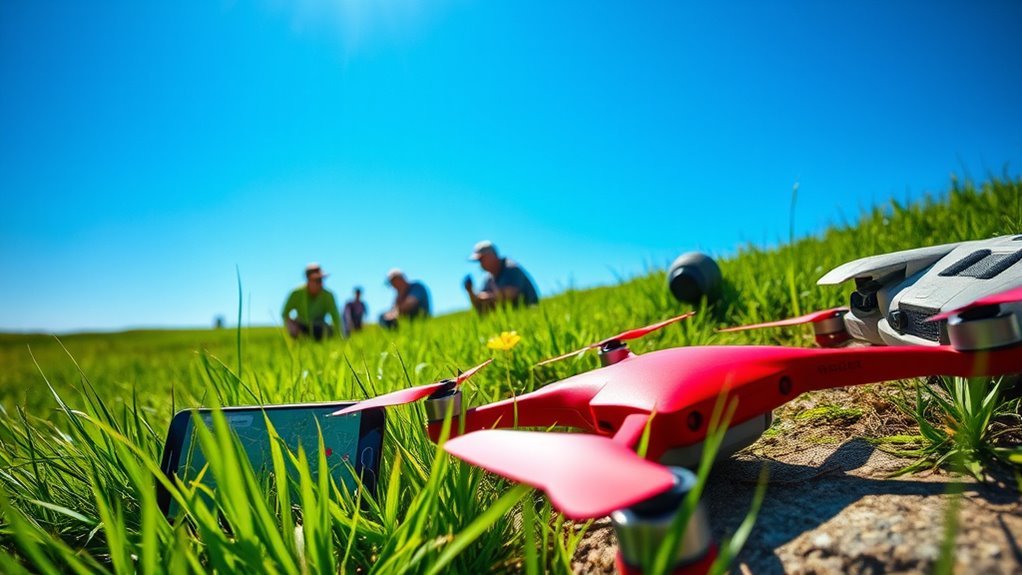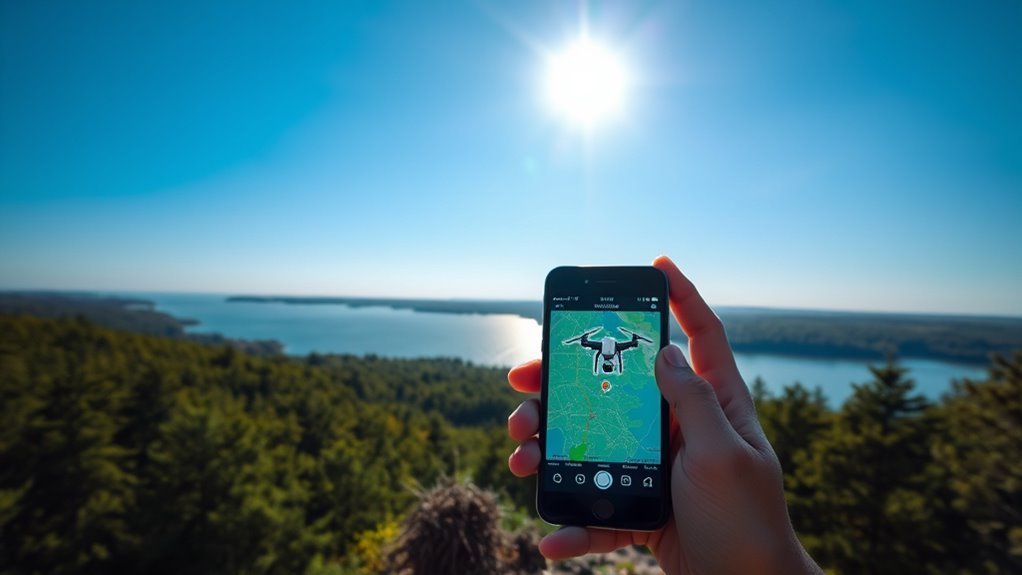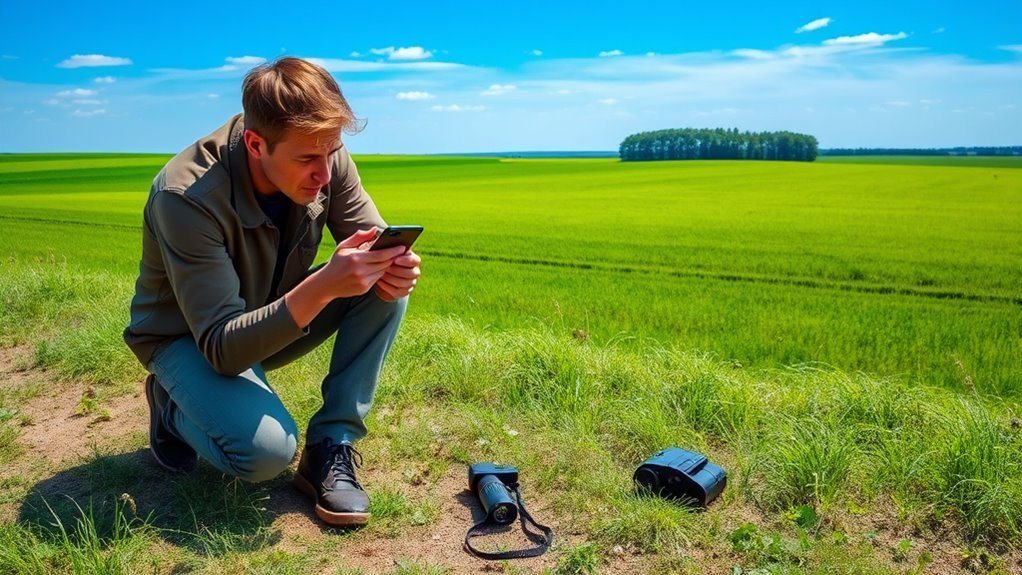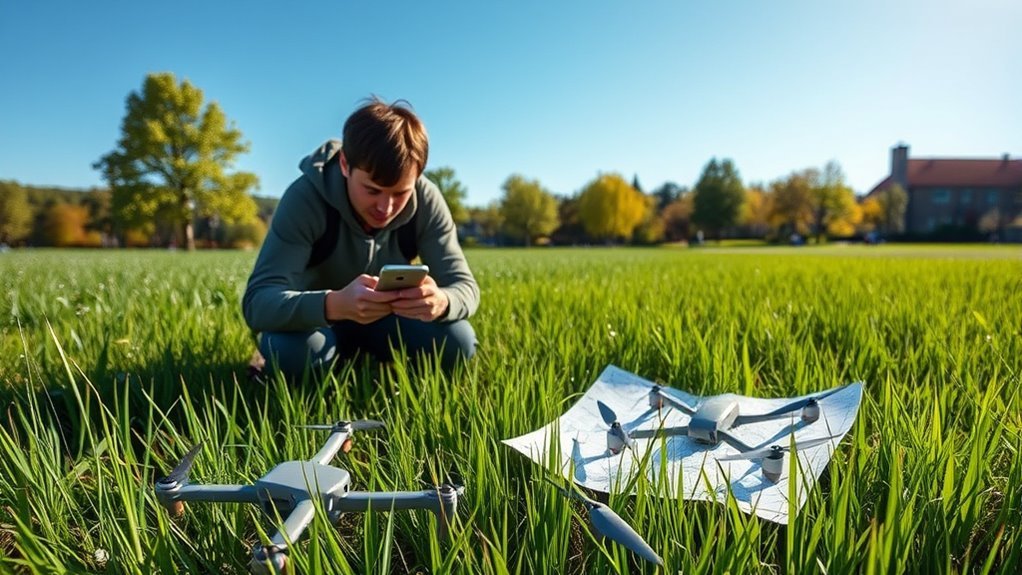If you’ve lost your drone, first stay calm and assess the situation. Use your drone’s GPS features through the app to track its last known location. Retrace your flight path and systematically search the area, dividing it into sections to cover more ground. Enlist friends or locals for extra help. Consider using a mobile drone finder. Familiarize yourself with local regulations regarding lost drones, and you’ll uncover more ways to retrieve your device effectively.
Stay Calm and Assess the Situation

When you’ve lost your drone, the first step is to take a deep breath and stay calm; panicking can cloud your judgment and hinder your ability to think clearly. Focus on evaluating the situation methodically. Start by recalling the last location where you operated the drone. Think about the flight path and any obstacles it may have encountered. Breathe deeply and allow your mind to process the data. Visualize the area, considering landmarks or features that could help you pinpoint its possible resting place. Stay focused on gathering information, both from your memory and the environment. This structured approach will provide clarity and confidence, empowering you to take further steps in the recovery process. Stay calm, and your chances of finding your drone will improve.
Use the Drone’s GPS and App Features

To locate your lost drone effectively, start by accessing its GPS location through the associated app. This feature typically provides real-time coordinates, which can greatly narrow down your search area. Additionally, explore other mobile app functionalities, such as map views or flight logs, to enhance your recovery efforts. Before each flight, remember to activate GPS tracking features to ensure accurate location data is available in case of loss.
Accessing GPS Location
How can you pinpoint the exact location of your lost drone? Start by utilizing its GPS tracking capabilities. Most drones come equipped with GPS modules that can provide real-time coordinates. If your drone’s app is synced with the device, check for any last known location data that might aid in drone recovery. Open the app, and navigate to the map interface where you should see the drone’s last recorded position. Pay attention to the accuracy of the GPS signal; this can vary based on your environment. If it’s near trees or buildings, the signal might be obstructed. By methodically analyzing the coordinates, you’ll be better equipped to venture to the location and retrieve your drone effectively.
Utilizing Mobile App Features
What features does your drone’s mobile app offer that can aid in locating your lost device? First, check for GPS tracking; it’s often your best ally. If your drone has gone out of range, the app may still show its last known location. Confirm your app compatibility is up to date, as feature updates can enhance tracking capabilities. Utilize any “Find My Drone” function, which might trigger alarms or lights to help you visually locate it. Pay attention to the app’s map interface; it can offer detailed terrain insights, which is vital if your drone’s downed in a less accessible area. Leveraging these app features systematically increases your chances of retrieving your cherished device.
Retrace Your Flight Path

To effectively retrace your flight path, start by analyzing the flight log stored in your drone’s app. This log provides critical data, including altitude changes and speed, which can help pinpoint where your drone last operated. Next, utilize map tools to visually track its route and identify potential areas to search.
Analyze Flight Log
While the thrill of flying a drone can be enthralling, losing track of it can quickly turn that excitement into frustration. To increase your chances of recovery, start by analyzing your flight log. This data reveals critical information about your drone’s path, altitude, and speed, helping you retrace its flight. Look for the last recorded position and note any landmarks it passed over. Pay attention to the flight duration as well; knowing how far it traveled can narrow your search area. By employing these recovery techniques, you can systematically assess where your drone might have landed. Leverage the flight data to maximize your efforts, ensuring you don’t miss any potential recovery points in your quest for freedom.
Use Map Tools
Using map tools can greatly enhance your search for a lost drone. By utilizing map navigation and aerial mapping applications, you can retrace your flight path more effectively. Start by accessing your drone’s flight logs to get a sense of the last known coordinates. Then, overlay those coordinates on a mapping tool to visualize the area.
| Feature | Purpose |
|---|---|
| Flight Path Replay | Visualize your route |
| Location Markers | Identify key landmarks |
| Area Measurement | Determine search radius |
This method allows you to systematically analyze the terrain and focus your search efforts in specific locations, increasing your chances of reclaiming your drone.
Conduct a Systematic Search
When you’ve lost your drone, conducting a systematic search can greatly increase your chances of recovering it. Start by employing effective search techniques; divide the area into smaller sections and tackle each one methodically. Use mapping strategies to create a visual representation of where you’ve already searched, marking off each section as you go. This way, you won’t waste time retracing your steps. Keep an eye out for distinctive landmarks or features to help orient yourself in the search area. As you search, maintain a consistent pace, scanning the ground and sky thoroughly. Remember, a calm and focused approach is key to maximizing your efficiency and enhancing your freedom to enjoy flying your drone again(Preventative Measures and Recommendations).
Enlist Help From Friends or Locals
Enlisting help from friends or locals can greatly broaden your search efforts and increase the likelihood of finding your lost drone. By engaging your community, you tap into a network of potential eyes and ears, enhancing your drone retrieval strategies.
| Action | Description |
|---|---|
| Mobilize Friends | Gather a group to cover more ground. |
| Local Outreach | Post on community boards or social media. |
| Search Teams | Organize small teams for systematic searches. |
Utilize a Mobile Drone Finder
Although losing a drone can be frustrating, employing a mobile drone finder can greatly streamline your search process. These tools leverage advanced drone tracking technology, allowing you to locate your device with precision. With mobile app integration, you can access real-time data, making your search efficient and focused.
- Use GPS capabilities for accurate location tracking.
- Receive alerts when the drone comes within range.
- Access maps and aerial views to navigate the area effectively.
Check Local Regulations and Reporting Options
After utilizing a mobile drone finder, it’s important to contemplate local regulations and reporting options that may apply to your situation. Understanding local laws is essential, as they dictate where you can operate your drone and the steps to take if it goes missing. Check if your area requires you to report a lost drone to authorities or local aviation bodies. Familiarize yourself with specific reporting procedures, which can vary greatly depending on your location. You may need to provide details like the drone’s last known position and any identifying information. By adhering to these regulations, you not only safeguard your rights as a drone operator but also contribute to the overall safety and integrity of the airspace.
Learn From the Experience for Future Flights
While losing a drone can be frustrating, it also presents an opportunity to analyze what went wrong and how to prevent similar incidents in the future. Reflecting on your experience helps you identify lessons learned and implement future precautions. Consider the following:
- Pre-flight checks: Always verify your drone’s battery is fully charged and all systems are functioning correctly. Additionally, ensure that your drone is registered with the FAA registration requirements to avoid legal complications in case of loss.
- Flight area assessment: Analyze the environment for potential hazards, like trees or obstacles, that could interfere with your flight path.
- GPS monitoring: Keep an eye on your drone’s GPS signal strength to avoid losing connection mid-flight. Additionally, always ensure compliance with local regulations to avoid flying into restricted areas that could lead to a loss of control.
Consider Insurance or Recovery Services
Reflecting on your past experiences can lead you to contemplate additional measures, such as drone insurance or recovery services. Evaluating your insurance options is vital; policies can cover loss, theft, or damage, providing peace of mind for your flights. Research various providers to find a plan that suits your needs without breaking the bank.
Recovery services, on the other hand, can act as a safety net. These specialized companies utilize advanced technology to locate lost drones, often increasing the chances of retrieval. Weighing the costs versus benefits of these services can empower you to make informed decisions. Ultimately, integrating insurance and recovery services into your drone usage strategy can enhance your freedom, allowing you to explore without fear of losing your investment.
Frequently Asked Questions
Can I Use a Metal Detector to Find My Drone?
You might think metal detection techniques could work for drone recovery methods, but it’s not guaranteed. Drones often contain non-metal parts, so using a metal detector alone may not yield the results you’re hoping for.
What Should I Do if My Drone Is Stuck in a Tree?
If your drone’s stuck in a tree, assess the situation first. Use drone retrieval techniques, but prioritize tree climbing safety. Consider using a long pole or enlisting help to avoid injury and recover your drone effectively.
How Can I Prevent Losing My Drone in the Future?
Imagine a sailor lost at sea without a map. To avoid similar drone misadventures, prioritize drone safety: always use a pre-flight checklist to guarantee proper settings, battery life, and environmental awareness before each flight.
Is It Possible to Track a Drone Without GPS?
You can track a drone without GPS through signal detection methods. By utilizing radio frequency identification or visual tracking techniques, you can pinpoint its location, though these methods may be less reliable than GPS-based drone tracking.
What Are the Costs Associated With Drone Recovery Services?
When considering drone recovery costs, you’ll find service pricing varies based on factors like location, complexity, and equipment needed. It’s crucial to compare options and assess the overall value versus potential replacement costs.

